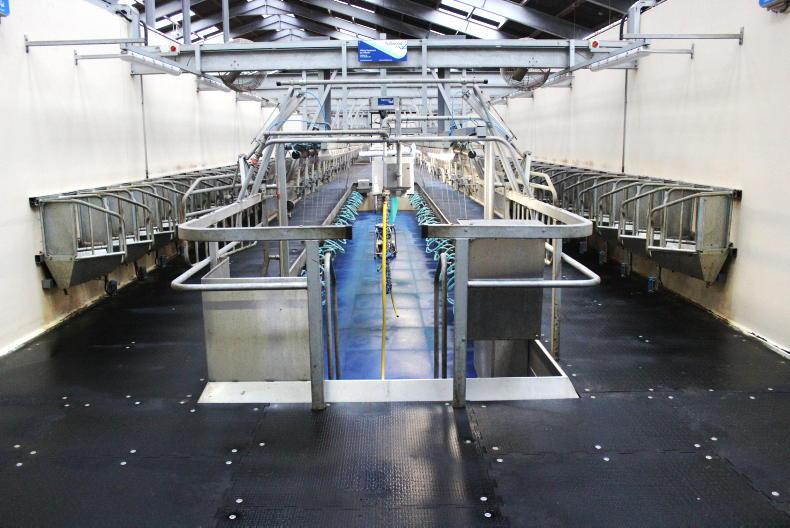Dairy farms have a high demand for electricity which comes at a cost, leading many farmers to go down the route of harnessing renewable energy to offset power drawn from the grid.
Options for reducing energy costs were outlined during a recent industry event hosted by the College of Agriculture, Food and Rural Enterprise (CAFRE).
Speakers based cost models on the energy used by the college’s dairy unit at Greenmount, Co Antrim.
Farm overview
The Greenmount dairy herd typically carries around 180 cows, with annual yields recorded at 8,615 litres/cow from 2.4t of concentrate, giving 3,121 litres of milk from forage.
Milk quality is 4.32% butterfat and 3.51% protein, giving 695kg of milk solids/cow each year. Although cows are high-yielding autumn-calving animals, there is a strong emphasis placed on grazing.
Parlour costs
Running the 16/32 dual-line milking parlour twice daily is by far the biggest user of electricity on the college dairy unit.
Estimates put power consumption for the parlour at 295kW/h/cow annually, which at a standardised cost of 30p/kWh (34c/kWh) per unit, means operating the milking unit costs £88/cow/year (€100).
As every parlour has multiple components, speakers broke down the main areas using the greatest amount of electricity.
It takes 900 litres of hot water to wash the parlour after each use.
Heating water to 55°C is the largest expense, accounting for 38% of total parlour costs at 113kWh/cow annually, or £34/cow (€39) at 30p/kWh.
Water is mainly heated overnight when electricity is at off-peak rates, although just over 50% of the energy used comes from the heat recovery unit during the milk cooling process.
The next-highest consumer of electricity was the milk cooling compressor, which uses 46kWh/cow annually or £14 (€16), followed by water heaters on the bulk tank using 34kWh/cow each year. The vacuum pump and air compressor use 26kWh and 21kWh per annum, respectively.
Solar energy
Improvements in battery storage systems that can be utilised by solar power means that roof panels are now a viable option for reducing the dairy unit’s energy costs and this option is under consideration. Batteries would allow the electricity generated during daytime to be stored and utilised overnight.
The rise in electricity costs from the national grid also means the payback period on solar energy is much faster than in previous years.
Vacuum pump
The dairy unit uses a variable speed vacuum pump, which has seen a 40% drop in energy use compared to a set speed pump, although this is below the industry standard of a 60% saving.
However, this can be attributed to the duration of wash cycle, as well as the parlour being a dual milking line setup, rather than a swing-over parlour with a single milk line.

The Future Herd at CAFRE, Greenmount.
At a cost of 30p/kWh, operating costs are now £6/day (€6.80) with the variable-speed pump, down from £10/day (€11.36) running costs for a set-speed pump, giving an overall saving of £1,412/year (€1,605).
The downside with variable speed pumps were outlined, which mainly come down to being more expensive and requiring a three-phase connection.
Plate cooler
Plate coolers are also used to lower energy use and, according to CAFRE advisers, offer the cheapest method of cooling milk before it hits the bulk tank.
Estimates indicate the plate cooler is using 1kWh of electricity for every 10kWh saving on heated water.
The plate cooler used uses two litres of cold water per litre of milk. This ensures there is maximum amount of heat being extracted from milk during the cooling process.
Rainwater is harvested from shed roofs and used in the system, but is sterilised by UV treatment beforehand.
Milk enters the plate cooler around 34.9°C and exits at 17°C, with a daily requirement of 4,460 litres of water used in the cooling process.
Once heated, this water is used for pressure washers and drinking troughs.
Lights
Plans are in place for replacing the 200W high-pressure sodium halide lights with 100W LEDs to lower running costs.
There is a night-light system in place, which is separate from the sodium lights.
On average, lights are switched on for four hours per day over the year.
Moving to the low-energy LED lights running over the same four-hour period every day would cost around £80/cow (€91). This includes purchase and installation costs and is based on 60% of light energy running on off-peak rates of 18.6p/kWh (21.1c/kWh) with daytime rates costed in at 30p/kWh.
Economic modelling outlined the current sodium bulbs use 292kWh annually, costing £67/each (€76), whereas the LEDs will lower this to 146kWh/year and cost £34 (€39) for every unit.
At the outlined cost saving, there is a payback period of just over two years by switching to the LED lighting option.
The potential for harnessing wind energy on the dairy unit is not really a viable option as the farm is located within a stone’s throw of the main airport in Northern Ireland, making it unlikely for planning permission to be granted on windmills.
However, while it is unlikely to be a runner for the CAFRE farm, speakers did stress that it would be a viable option for other dairy farmers.
180 cows (90% September to December calving).8,615 litres/cow/year.4.32% butterfat and 3.51% protein (695kg MS/cow).2.4t concentrate/cow (0.29kg/l).3,121 litres/cow/year from forage.
Read more
Calf rearing: do your budgets before you purchase
Watch: Footprint Farmers - The power of nutrient management planning
Dairy farms have a high demand for electricity which comes at a cost, leading many farmers to go down the route of harnessing renewable energy to offset power drawn from the grid.
Options for reducing energy costs were outlined during a recent industry event hosted by the College of Agriculture, Food and Rural Enterprise (CAFRE).
Speakers based cost models on the energy used by the college’s dairy unit at Greenmount, Co Antrim.
Farm overview
The Greenmount dairy herd typically carries around 180 cows, with annual yields recorded at 8,615 litres/cow from 2.4t of concentrate, giving 3,121 litres of milk from forage.
Milk quality is 4.32% butterfat and 3.51% protein, giving 695kg of milk solids/cow each year. Although cows are high-yielding autumn-calving animals, there is a strong emphasis placed on grazing.
Parlour costs
Running the 16/32 dual-line milking parlour twice daily is by far the biggest user of electricity on the college dairy unit.
Estimates put power consumption for the parlour at 295kW/h/cow annually, which at a standardised cost of 30p/kWh (34c/kWh) per unit, means operating the milking unit costs £88/cow/year (€100).
As every parlour has multiple components, speakers broke down the main areas using the greatest amount of electricity.
It takes 900 litres of hot water to wash the parlour after each use.
Heating water to 55°C is the largest expense, accounting for 38% of total parlour costs at 113kWh/cow annually, or £34/cow (€39) at 30p/kWh.
Water is mainly heated overnight when electricity is at off-peak rates, although just over 50% of the energy used comes from the heat recovery unit during the milk cooling process.
The next-highest consumer of electricity was the milk cooling compressor, which uses 46kWh/cow annually or £14 (€16), followed by water heaters on the bulk tank using 34kWh/cow each year. The vacuum pump and air compressor use 26kWh and 21kWh per annum, respectively.
Solar energy
Improvements in battery storage systems that can be utilised by solar power means that roof panels are now a viable option for reducing the dairy unit’s energy costs and this option is under consideration. Batteries would allow the electricity generated during daytime to be stored and utilised overnight.
The rise in electricity costs from the national grid also means the payback period on solar energy is much faster than in previous years.
Vacuum pump
The dairy unit uses a variable speed vacuum pump, which has seen a 40% drop in energy use compared to a set speed pump, although this is below the industry standard of a 60% saving.
However, this can be attributed to the duration of wash cycle, as well as the parlour being a dual milking line setup, rather than a swing-over parlour with a single milk line.

The Future Herd at CAFRE, Greenmount.
At a cost of 30p/kWh, operating costs are now £6/day (€6.80) with the variable-speed pump, down from £10/day (€11.36) running costs for a set-speed pump, giving an overall saving of £1,412/year (€1,605).
The downside with variable speed pumps were outlined, which mainly come down to being more expensive and requiring a three-phase connection.
Plate cooler
Plate coolers are also used to lower energy use and, according to CAFRE advisers, offer the cheapest method of cooling milk before it hits the bulk tank.
Estimates indicate the plate cooler is using 1kWh of electricity for every 10kWh saving on heated water.
The plate cooler used uses two litres of cold water per litre of milk. This ensures there is maximum amount of heat being extracted from milk during the cooling process.
Rainwater is harvested from shed roofs and used in the system, but is sterilised by UV treatment beforehand.
Milk enters the plate cooler around 34.9°C and exits at 17°C, with a daily requirement of 4,460 litres of water used in the cooling process.
Once heated, this water is used for pressure washers and drinking troughs.
Lights
Plans are in place for replacing the 200W high-pressure sodium halide lights with 100W LEDs to lower running costs.
There is a night-light system in place, which is separate from the sodium lights.
On average, lights are switched on for four hours per day over the year.
Moving to the low-energy LED lights running over the same four-hour period every day would cost around £80/cow (€91). This includes purchase and installation costs and is based on 60% of light energy running on off-peak rates of 18.6p/kWh (21.1c/kWh) with daytime rates costed in at 30p/kWh.
Economic modelling outlined the current sodium bulbs use 292kWh annually, costing £67/each (€76), whereas the LEDs will lower this to 146kWh/year and cost £34 (€39) for every unit.
At the outlined cost saving, there is a payback period of just over two years by switching to the LED lighting option.
The potential for harnessing wind energy on the dairy unit is not really a viable option as the farm is located within a stone’s throw of the main airport in Northern Ireland, making it unlikely for planning permission to be granted on windmills.
However, while it is unlikely to be a runner for the CAFRE farm, speakers did stress that it would be a viable option for other dairy farmers.
180 cows (90% September to December calving).8,615 litres/cow/year.4.32% butterfat and 3.51% protein (695kg MS/cow).2.4t concentrate/cow (0.29kg/l).3,121 litres/cow/year from forage.
Read more
Calf rearing: do your budgets before you purchase
Watch: Footprint Farmers - The power of nutrient management planning








 This is a subscriber-only article
This is a subscriber-only article











SHARING OPTIONS: